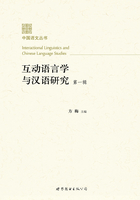
5.结论和余语
本文主要讨论了对汉语会话基本单位(TCU)的辨识所需要考虑的诸种因素,以及怎样的TCU可以实现为最佳话轮投射单位。我们主张不能只单独考虑句法因素,应从句法和韵律互动的角度来综合考察汉语TCU的性质和特点。这里需要说明的是,随着近些年互动语言学的发展,学者们(如Ford et al.,1996等)除了从句法、韵律、语用等角度,还从身势、眼神等多模态视角来理解TCU的话轮投射作用。研究发现,话轮的完结和投射不只依靠句法的完结,还依靠语境中的会话行为,通过韵律语调,可能还会伴随身体动作一同来预示话轮的完结和转换。这种结合副语言因素的综合性研究范式应该对理解汉语的TCU起到积极作用。这是本研究并未涉及的,主要受到研究的语料和研究者能力的限制。但是,汉语这方面的最新研究成果已经出现,可以参看Li(2014)。
互动语言学近些年来发展的尤为迅速,它是通过言谈会话这种交际模式,来考察会话功能、语法结构和人类社交之间的互育(cross-fertilization)关系。简言之,会话语境为语法结构的形成提供沃土,语法结构在会话交际中要完成一定的互动功能,从而使人们的日常社会交际能顺利推进。
会话交际的基本单位(TCU)不是一套静止的语言单位,而是从交际实践中产生的副现象(epiphenomena)。这和功能语言学家的语法观是一脉相承的,Hopper(1998:150)在阐述他提出的浮现语法理论时,明确说到:“语法不是交际的起源和根本,而是交际的副产品。换言之,语法是副现象。”目前功能语法学家面临的主要挑战之一就是如何用对话运作的结构规律来解释语法规律。因为语言规律存在于言语活动之中,而言语活动的主要形式就是会话。所以,Schegloff(1996)说到,语法要放在它所栖息的互动交际中去理解。
参考文献
陆镜光2000 《句子成分的后置与话轮交替机制中的话轮后续手段》, 《中国语文》第4期。
陆镜光2002 《在进行中的句子里辨识句末》,载邵敬敏、徐列炯编《汉语语法研究的新拓展(一)》,浙江教育出版社,356-374。
陆镜光2004 《延伸句的跨语言对比》, 《语言教学与研究》第6期。
陆镜光2005 《说延伸句》,载中国社会科学院语言研究所《中国语文》编辑部编,《庆祝〈中国语文〉创刊50周年学术论文集》,商务印书馆,39-48。
陆萍 李知沅 陶红印2014 《现代汉语口语中特殊话语语音成分的转写研究》, 《语言科学》第2期。
范继淹1985 《汉语句段结构》, 《中国语文》第1期。
胡明扬 劲松1989 《流水句初探》, 《语言教学与研究》第4期。
林茂灿2012 《汉语语调实验研究》,中国社会科学出版社。
吕叔湘1979 《汉语语法分析问题》,商务印书馆。
吕叔湘2008 《语音的“句”和语法的“句”》,载《语文常谈》,生活·读书·新知三联书店,51-52。
沈家煊2007 《汉语里的名词和动词》, 《汉藏语学报》第1期。
沈家煊2012 《“零句”和“流水句”》, 《中国语文》第5期。
宋柔2008 《现代汉语跨标点句句法关系的性质研究》, 《世界汉语教学》第2期。
宋柔2013 《汉语篇章广义话题结构的流水模型》, 《中国语文》第6期。
陶红印2004 《口语研究的若干理论与实践问题》, 《语言科学》第1期。
王洪君2011 《汉语语法的基本单位与研究策略》(作者补记),载《基本单字的现代汉语词法研究》,商务印书馆,393-420。
王洪君 李榕2014 《论汉语语篇的基本单位和流水句的成因》, 《语言学论丛》(第49辑),商务印书馆,11-40。
邢福义1995 《小句中枢说》, 《中国语文》第6期。
乐耀2014 《互动语言学研究的重要课题:会话交际的基本单位》(待刊)。朱德熙1982 《语法讲义》,商务印书馆。
朱德熙1985 《语法答问》,商务印书馆。
Auer, Peter 1992 The neverending sentence: Rightward expansion in spoken language.In Miklós,Kontra and Tamás,Várdi(eds.)Studies in spoken languages:English, German, Finno-Ugric. Budapest: Linguistics Institute. Hungarian Academy of Sciences, 41-59.
Biq, Yung-O 2000 Recent developments in discourse-and-grammar. Chinese Studies 18:357-394.
Chafe, Wallace 1987 Cognitive constraints on information flow. In Tomlin, Russell S.(ed.)Coherence and Grounding in Discourse.Amsterdam/Philadelphia:John Benjamins Publishing Company, 21-51.
Chao,Yuen Ren 1968 A Grammar of Spoken Chinese.Berkeley and Los Angeles:University of California Press.(吕叔湘节译本《汉语口语语法》,1979,北京:商务印书馆。)
Clayman, Steven E. 2013 Turn-Constructional Units and the Transition-Relevance Place.In Sidnell,Jack and Tanya Stivers(eds.)The Handbook of Conversation Analysis.Oxford:Blackwell Publishing Ltd.,150-166.
Du Bois, John, Stephan Schuetze-Coburn, Danae Paolino & Susanna Cumming 1993 Outline of discourse transcription. In Edwards, Jane A. and Martin D.Lampert(eds.)Talking Data:Transcription and Coding Methods for Language Research.Hillsdale,NJ:Lawrence Erlbaum,45-89.
Du Bois, John W. 2004 Representing Discourse. MS, University of California, Santa Barbara.
Ford,Cecilia E. 2004 Contingency and units in interaction.Discourse Studies 6:27-52.
Ford, Cecilia E. & Sandra A. Thompson 1996 Interactional units in conversation:Syntactic, intonational, and pragmatic resources for the projection of turn completion. In Elinor Ochs, Emanuel A. Schegloff, and Sandra A. Thompson, (eds.)Interaction and Grammar.Cambridge:Cambridge University Press,135-184.
Ford, Cecilia E., Barbara A. Fox & Sandra A. Thompson 1996 Practices in the construction of turns:the‘TCU'revisited.Pragmatics 6(3):427-454.
Ford, Cecilia E., Barbara A. Fox & Sandra A. Thompson 2002 Constituency and the grammar of turn increments. In Ford, Cecilia E., Barbara A. Fox and Sandra A. Thompson, (eds.) The Language of Turn and Sequence. Oxford: Oxford University Press, 14-38.
Fox, Barbara A., Thompson, Sandra A., Ford, Cecilia E. & Couper-Kuhlen, Elizabeth 2013 Conversation Analysis and Linguistics. In Sidnell, Jack and Tanya Stivers(eds.)The Handbook of Conversation Analysis.Oxford:Blackwell Publishing Ltd., 726-740.
Halliday,M.A.K. 1994 An Introduction to Functional Grammar.London:Edward Arnold.
Hopper,Paul 1987 Emergent grammar.Berkeley Linguistic Society 13:139-157.
Hopper, Paul 1998 Emergent grammar. In Tomasello, Michael (ed.) The New Psychology of Language: Cognitive and Functional Approaches to Language Structure.Mahwah,NJ:Lawrence Erlbaum,155-175.
Houtkoop, Hanneke & Mazeland, Harrie 1985 Turns and discourse units in everyday conversation.Journal of Pragmatics 9:595-619.
Kern, Friederike & Selting, Margret 2013 Conversation Analysis and Interactional Linguistics.In Chapelle,Carol A.(ed.)The Encyclopedia of Applied Linguistics. Oxford: Blackwell Publishing Ltd., 1-5.
Lerner,Gene 1991 On the syntax of sentences-in-progress.Language in Society 20 (3): 441-458.
Li Xiaoting 2014 Multimodality, Interaction and Turn-taking in Mandarin Conversation.Amsterdam/Philadelphia:John Benjamins.
Miller, Jim 1995 Does spoken language have sentences? In Palmer, Frank R. (ed.) Grammar and Meaning: Essays in Honour of SIR JOHN LYONS. Cambridge:Cambridge University Press, 116-135.
Ochs,Elinor,Emanuel A.Schegloff&Sandra A.Thompson(eds.) 1996 Interaction and Grammar.Cambridge:Cambridge University Press.
Sacks, Harvey, Emanuel A. Schegloff & Gail Jefferson 1974 A simplest systematics for the organization of turn-taking for conversation.Language 50(4):696-735.
Schegloff, Emanuel A. 2007 Sequence Organization in Interaction:A Primer in Conversation Analysis,Vol.1.Cambridge:Cambridge University Press.
Selting, Margret 1996 On the interplay of syntax and prosody in the constitution of turn-constructional units and turns in conversation.Pragmatics 6(3):357-388.
Selting,Margret 2000 The construction of units in conversational talk.Language in Society 29:477-517.
Selting, Margret 2005 Syntax and prosody as methods for the construction and identification of turn-constructional units in conversation. In Hakulinen, Auli and Margret Selting(eds.)Syntax and Lexis in Conversation.Amsterdam:Benjamins, 17-44.
Selting,Margret&Elizabeth Couper-Kuhlen(eds.) 2001 Studies in Interactional Linguistics.Amsterdam/Philadelphia:John Benjamins.
Tao, Hongyin 1996 Units in Mandarin Conversation:Prosody, Discourse, and Grammar.Amsterdam/Philadelphia:John Benjamins.
Thompson, Sandra A. & Elizabeth Couper-Kuhlen 2005 The clause as a locus of grammar and interaction.Discourse Studies 7,4/5:481-505.
附录:本文例句所涉及的口语转写体例
(1)按语调单位分行转写,一个语调单位一行。
(2)当前说话人话语的结束:IU后用“。”标注;话语未完:IU后用“, ”标注;IU若是疑问语调,其后用“? ”标注。
(3)中停顿标记成“...”,是在0.3-0.6秒间,包括0.3和0.6,这类停顿不用标明时长;短停顿标成“..”,是小于等于0.2秒,不注明时长。
(4)将话语重叠部分置于“[ ]”内。
(5)用“--”表示在完成一个完整的语调单位曲拱之前,该语调单位被截断。
(6)话语中出现引语,将引语内容放在“< >”中,前后用引语Quotation首字母Q表示,即“< Q Q>”。
(7)听不太清楚的部分放在“<X X>”中,完全听不出来的直接标注“<XXX>”。
(8)笑声用“<@@>”表示。
(9)延长用等号标明“=”。
(10)标注者或研究者的主观评论置于“(())”中。
(11)将背景噪音很大,听不很清楚,但可以识别出的话语内容放入“()”中。